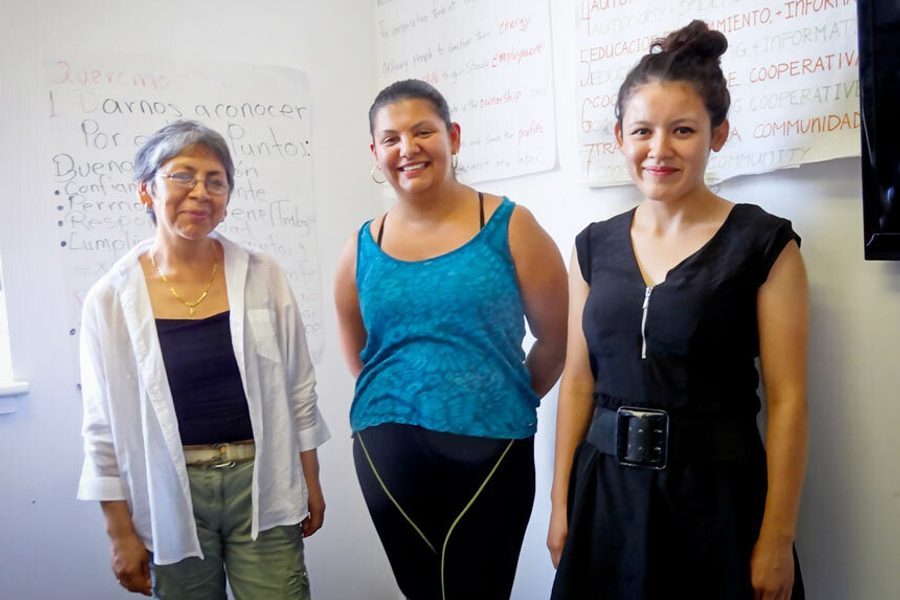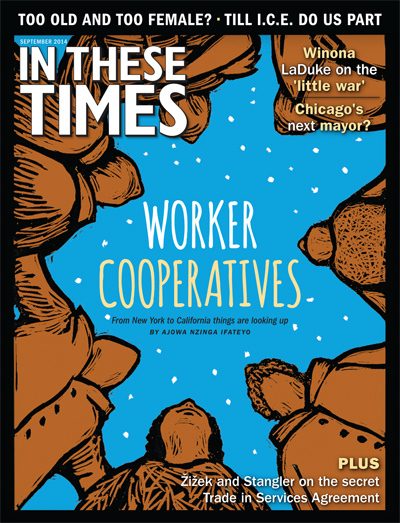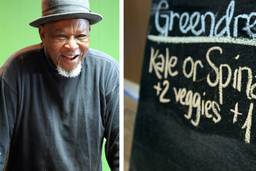
In 2006, Daniela Salazar, then a 22-year-old mother of two, was making about $7.25 an hour doing restaurant work and housecleaning. For three hours every month, she also stood on the street in Brooklyn with 12 other women passing out flyers, rain or shine (and sometimes snow).
They were promoting a cleaning company of a new kind: one that would not only provide them with jobs and more money to support their families, but would also make them business owners.
That company was a worker cooperative called Sí Se Puede—“Yes, We Can” in Spanish. The women started the co-op with the help of the SCO Family of Services’ Center for Family Life, a social-service agency and advocacy group for families. They marketed their business in this low-tech way for months, slowly building up a clientele until they could afford a website.
Eight years later, Sí Se Puede has 64 member-owners. It grossed over a million dollars in 2013. The worker co-op may soon have another source of income: a line of cleaning products. Salazar’s pay at Sí Se Puede has climbed to $20 to $23 an hour, letting her work fewer hours a week and spend more time with her family, which has grown to include three children.
Back when she was leafleting on corners, Salazar never imagined that the business would enjoy such success.
“In the beginning, it was very hard to grow,” she says laughing. “We look back, and we are amazed.”
The worker cooperative model, in which a business is owned and controlled by its members, is rarely taught in U.S. business schools, but it is gaining a reputation as a way for social service agencies and city councils to provide jobs for workers marooned by the current economy.
“There just aren’t enough jobs for all the people who need and want them,” says Jessica Gordon Nembhard, associate professor of community justice and social economic development at New York’s John Jay College, and author of Collective Courage: A History of African American Cooperative Economic Thought and Practice. “Worker cooperatives address that niche.”
Social and economic justice activists also favor worker cooperatives as a way of enabling workers to participate democratically in their workplace. Co-ops are seen as a key component of what is called the “solidarity economy.” That term encompasses democratic, environmentally conscious and socially responsible companies, along with alternative exchanges such as trade and bartering — any economic system that emphasizes concern for people and economic justice over pure profit.
“Worker cooperatives are one of the best solidarity economy structures for solving the problem of participation and ownership,” says Gordon Nembhard. “When you own a business, you end up with a good stable job that you have control over and an asset that can appreciate over time and give you some stability.”
The worker cooperative movement got a major boost in June when the City Council of New York established a Worker Cooperative Business Development Initiative and put up $1.2 million to fund it. The money will go to 11 organizations to establish 28 new worker co-ops, create 234 jobs in co- ops and support agencies, and provide education, training and technical support to another 20 existing co-ops, including Sí Se Puede.
New York City is the first municipality to allocate such a large sum to worker cooperative development. This initiative “resonates far beyond New York,” says Melissa Hoover, executive director of the U.S. Federation of Worker Cooperatives, a national grassroots membership organization that supports the co-op movement. “The visibility is really huge.”
The rise of worker co-ops
Co-ops have a long and varied history in the United States. Some 250 years ago, New York City was the site of the first known U.S. worker cooperative, according to historian John Curl, author of For All the People: Uncovering the Hidden History of Cooperation, Cooperative Movements, and Communalism in America. In 1768, 20 journeymen tailors walked off the job because of a reduction in pay and then set up an ad hoc cooperative.
“This was the first recorded wage earners’ strike against a boss in America,” says Curl. “To help support themselves during the strike, the tailors set up their own cooperative ‘house of call’ in opposition to their masters. Finding themselves locked out and their jobs filled by scabs, they tried to make a go of their cooperative. History does not record their degree of success.”
History does record the success of the Knights of Labor, an organization started in 1869 by the striking Philadelphia tailoring cutters’ trade union that aimed to establish “co-operative institutions” to supersede the wage system. By 1886, between 185 and 200 Knight cooperatives existed all over the United States, concentrated in the East and Midwest, in industries ranging from mines to foundries to mills to factories to artisans’ shops. One could buy co-op – made barrels, boxes, clothes, shoes, underwear, soap, brooms, pipes and stoves. In New York, the Knights organized two leather goods factories, a plumbers’ cooperative, a publishing business, a watch case factory, a cigar factory and a store to sell the cigars.
The Knights were one of the first unions to include women and to be racially integrated. They had attracted between 60,000 and 95,000 African-American members by 1887, according to Gordon Nembhard, and spawned black-owned industrial cooperatives, including an Alabama cotton gin.
The Knights thrived for a decade but were eventually crushed by big businesses, which rallied to stamp out this new and disturbing breed of competition, refusing to ship goods made by cooperatives, sell machinery and materials to them, or issue them bank loans.
As Gordon Nembhard documents in Collective Courage, other predominantly black unions and populist organizations supporting workers’ rights, land ownership and cooperatives, particularly among farmers, continued to rise at the end of the 19th century and the beginning of the 20th. Like the Knights, they were often thwarted: White vigilantes and competitors did their best to destroy them. But many survived. By 1907, W.E.B. Dubois, a strong advocate of economic cooperation as a survival strategy, counted 156 cooperatives established by African Americans. Gordon Nembhard argues that these were among the roots of black attempts to build an alternative economy throughout the 20th century (such as the Freedom Quilting Bee collective, founded in the 1960s).
Co-ops made a comeback during the Great Depression, fostered by the federal government as part of the New Deal, but they faded in the post-war era. Then, in the 1960s and 1970s, worker cooperatives rose again in cities including Berkeley, California; San Francisco; Seattle; Portland, Oregon; Boston; Minneapolis; Madison, Wisconsin; New Haven, Connecticut; and Austin, Texas. The Cheese Board Collective, founded in 1971 in San Francisco, is believed to be one of the oldest worker cooperatives in the country that’s still in operation. The collective established Arizmendi Bakeries, a group of franchise-like, but independent, cooperatives that sell pizza. The well-loved bakeries continue to spread across the Bay Area, inheriting money, expertise and even sourdough starter from their sister co-ops.
Today, according to the U.S. Federation of Worker Cooperatives, the United States has more than 300 worker cooperatives in fields ranging from engineering, architecture and computer technology to taxi driving, house cleaning and construction. Some co-ops are small enough that all members participate in day-to-day decisions, while larger co-ops may be managed through boards and committees. The 2,300 members of the Bronx-based Cooperative Home Care Associates elect a governing board, which then appoints a manager. In San Francisco, the 220-member Rainbow Grocery is managed by volunteer committees of workers and an elected steering committee.
California leads the country in worker cooperatives with 56, according to data from the University of Wisconsin’s Center for Cooperatives and the University of Iowa’s Department of Economics. New York State has the second-most with 40, and Massachusetts comes in third with 25. Chicago has nine worker cooperatives, the most well-known of which is the New Era Windows Cooperative (formerly Republic Windows and Doors), formed after fired workers occupied their factory in 2008. Worker cooperatives are blossoming, in particular, among immigrants who struggle to find employment because they are undocumented, have difficulty speaking English or lack particular job skills.
Many of the cooperatives around the United States were inspired by the Mondragon Cooperative Corporation in Spain, which started in 1956. Today, the Mondragon family of businesses employs 80,321 people in 289 companies, 110 of which are cooperatives. Mondragon weathered the economic slowdown better than many traditional companies. Instead of laying off workers, Mondragon simply trained them for other careers in their network of businesses. Its profit in 2012 was 12.9 billion Euros (about 15.5 billion U.S. dollars).
While Mondragon has been criticized for practices that may exploit workers in the Global South, Mondragon spokesperson Mikel Lezamiz said that the cooperative corporation is bound by the laws of the countries in which they operate. “In some of the plants, we offered employees [the right] to become worker-owner members, but the trade unions didn’t accept it,” he says. “In all the plants, we [offer] workers normally better conditions than our competitors.” He adds that most Mondragon plants overseas share 10 to 20 percent of net profits with employees.
Only in New York
Despite the long history of worker co-ops in the United States, only recently have municipalities considered cooperatives as a solution to a sluggish economy in which jobs are scarce and well-paying jobs even scarcer. Richmond, California, emerged as a pioneer of co-op development four years ago when Mayor Gayle McLaughlin, a Green Party member, was looking for ways to create jobs for low-income residents. Taking inspiration from a 2010 visit to the Mondragon headquarters in Spain, she had Richmond allocate $50,000 for a consultant to lead the creation of three cooperatives, which in turn inspired an anonymous donation of $50,000 for a worker co-op loan fund.
Last year, all eyes turned to Jackson, Mississippi, where newly elected Mayor Chokwe Lumumba made worker co-op development a centerpiece of his plan for a progressive overhaul of the city. Lumumba planned to establish a co-op incubator within the city’s Department of Planning and Development and apply city funds to cooperative development. But Lumumba died in February, before he could realize his vision. Had he succeeded, Jackson would have boasted the most substantial city-led cooperative development in the country. The new mayor, Tony Yarber, has made no moves to continue any of these projects, but Cooperation Jackson — the network of local worker cooperatives that Lumumba planned — continues to organize independently.
So how did New York City take the lead to become a beacon for worker cooperative development?
Enter the New York-based Federation of Protestant Welfare Agencies (FPWA), a 90-year-old anti-poverty association made up of 200 religious groups and community organizations, including daycare, domestic violence and senior centers. As the effects of the 2008 economic downturn reverberated through the city, with the ranks of the poor swelling by almost 2 million in 2012, the FPWA was seeking new solutions to the problem of poverty. It found it was having difficulty placing trainees from its workplace development department into jobs. Then it got wind of the work of the Center for Family Life, which has incubated four successful worker cooperatives since 2006, including Sí Se Puede.
The FPWA contacted the center and various worker cooperatives and incubators to learn about their needs. The group also studied cooperatives in other U.S. cities and in Canada, Spain and Italy. They heard the same thing repeatedly: To get a mass movement of co-ops off the ground, a public investment is needed.
So the FPWA deployed its contacts, clout, City Hall connections and considerable political know-how. First, it helped bring together worker cooperatives, anti-poverty groups and support organizations to form the Coalition for Worker Cooperatives for New York City, a grassroots campaign to lobby the city to support worker cooperative development as a job creation and wealth-building vehicle.
“They brought a lot of sophistication to how all of the people in this space were operating in relation to the City Council,” says Julia Jean-Francois, codirector of the Center for Family Life, a member of the coalition. “They got us all together and they sketched out an agenda. It was a very thorough approach.”
In January, the FPWA kicked off its year of research with a policy report, “Worker Cooperatives for New York City: A Vision for Addressing Income Inequality.” It laid out New York’s income stratification in clear terms: Income inequality is at a historic high in New York. The income of the lowest fifth of New York’s population was $8,993, while the highest fifth made $222,871 and the top 5 percent made $436,931, which was about 49 times as much as those with the lowest income. Based on 2012 U.S. Census data, it paints a troubling picture of the struggles of many New Yorkers living in poverty and income inequality. The city’s poverty rate rose to 21.2 percent in 2012 from 20.9 percent in 2011.
Noting that worker cooperatives generally provide higher wages than other businesses — not to mention the opportunity for workers to share in profits — the report urged the city to support worker cooperatives as a way to combat inequality.
After releasing the report, the FPWA organized a policy conference and invited government officials. City Council member Maria del Carmen Arroyo, who had just been appointed chair of the Community Development Committee, attended and was blown away.
“It was quite serendipitous,” she says. “It was like, wow — this was something that we need to have a follow-up conversation on.”
In February, Arroyo organized a hearing before the City Council. Fifty worker cooperative owners, advocates, technical support organizations and city officials attended.
“The question that we posed was: ‘Are worker cooperatives a vehicle to help raise people out of poverty?’ ” Arroyo says. “Everyone said, ‘Yes.’ ”
The wheels were in motion. From February through June, local cooperatives and their supporters kept the momentum going by attending hearings, budget meetings and press conferences, and organizing a Co-op Advocacy Day on May 14 on the steps of City Hall. The coalition gained the support of Council Speaker Melissa Mark-Viverito.
Some credit FPWA’s new director, Jennifer Jones Austin, for building a winning strategy. A child of civil rights activists, Austin, who took the job in November 2012, has a long history in social services and economic development, including serving on Mayor Michael Bloomberg’s Commission for Economic Opportunity. She also worked for now-Mayor Bill de Blasio when he was a Brooklyn city commissioner, and she was named co-chair of de Blasio’s transition team.
As a result of the coalition’s organizing work, de Blasio proclaimed June 21 “New York Worker Cooperative Day.” That same day, New York held its first annual worker cooperative conference, titled “Economic Democracy and Economic Justice: The Tale of a New City.”
The name was a play on de Blasio’s inaugural comments in January, when he spoke of New York as a “tale of two cities” and pledged to take action, including taxing the rich, to shrink the inequality gap. New York’s Worker Cooperative Development Initiative offers de Blasio an opportunity to distinguish his administration from the conservatism of the Bloomberg administration and to make good on his promises to lessen the city’s income divide.
On June 26, the City Council voted to allocate the $1.2 million.
Getting off the ground
“Co-ops tend to be more difficult to get started than conventional businesses,” says Marilyn Langlois, the coordinator of the Richmond Worker Cooperative Revolving Loan Fund, which provides loans of up to $20,000 for worker cooperative development and maintenance. “But once they’re up and running, they tend to be very sustainable.” Indeed, it’s not easy to create a co-op within a system that, for centuries, has celebrated profits over people and individualism over the good of the whole. All businesses need a business plan, a source of reliable funding and professionals like lawyers and accountants, but worker cooperatives face the additional challenge of learning how to operate democratically. They must figure out how to make decisions (by consensus, voting, or some other process), and then decide such questions as the rights and responsibilities of member-owners, how much money will go to workers as profits and how much will go back into operations or reserves, how to cut ties with cooperative members who do not work out, and how to handle grievances.
Not to mention that the founders of worker cooperatives are often women, immigrants, low-income people and people of color, who face additional challenges. They may have internalized racism, sexism and classism, and need coaching and confidence-boosting to believe that business ownership is not only for the white, wealthy and male.
Studies show that all of the extra work pays off. Once workers run their own businesses, they put more into them — they stay on jobs longer and are more productive and happy. People who start worker cooperatives also gain education and organizing skills “which means that they then also contribute to an educated civic society,” Gordon Nembhard says.
A study by the Employment Research Institute at Edinburgh Napier University in Scotland reports that worker cooperatives have long-term benefits for the worker-owners, who feel more empowered and in control than other workers, and enjoy a far greater sense of job security and achievement. Nearly 80 percent of the employee-owners featured in the study were happy to recommend their organization as a place to work.
Significantly, cooperative businesses don’t just make for happier workers; they’re also more viable than conventional businesses. An April 2013 study by Erik Olsen at the University of Missouri, Kansas City, found that “once created, the expected survival of worker cooperatives meets or exceeds that of conventionally owned firms.” While data was not available for U.S. firms, the average lifespan of worker cooperatives in Canada is more than four times longer than conventional businesses, the study noted.
New York’s game plan
New York’s $1.2 million grant will be allocated to 11 worker-cooperative support organizations, including FPWA, in amounts ranging from $35,000 to $230,000. They include:
The Center for Family Life, which will incubate four new co-ops
The New York City Network of worker Cooperatives, which, among other things, will work to convince business owners in the city’s 21 industrial business zones to sell their shops to workers
The Urban Justice Center, which will provide legal services for start-up co-ops
Green Worker Cooperatives, an incubator service started in the Bronx in 2003 to create “green” worker-owned businesses
The Democracy at Work Institute, which will train the City’s Department of Small Business Services so it can recommend the worker-cooperative model to entrepreneurs
Make the Road New York, which plans to lauch two new cooperatives and continue supporting an existing co-op, Pa’lante Green Cleaning, to become self-sustaining
Right now, the city is hedging its bets. The grant expires in June 2015.
Melissa Hoover of the U.S. Federation of Worker Cooperatives cautions that a year is not enough time get a co-op off the ground. “Co-op development is a long process,” she says. “In order to be effective, you need multi-year funding, and more of it.”
However, she adds that what’s more important than money is the relationship and capacity-building that’s underway — associations that can continue even if the project isn’t renewed in 2016.
For example, three of the grantees — economic opportunity consulting firm ICA Group, the New York City Network of Worker Cooperatives and The Working World, a community development fund — have an eye toward figuring out how co-ops can get a share of the $16.5 billion New York City spends on contractors annually.
“Our long-term objective beyond the first year — regardless of whether or not the city continues to fund it — is to try to create a way that the city is spending money on businesses owned and operated by residents of the city, hopefully low-income residents,” says David Hammer, director of the ICA Group. “That keeps the money inside the city and promotes economic development for the people who need it most.”
At the same time, he notes, a symbolic point has already been made. “We spend so much of our time at work but without the rights of control. What the city has done is said, ‘That’s not right, and we’re going to put money into trying to change it.’ That’s a huge shift,” Hammer says. “If we are successful in creating a cooperative economy in New York City, we’re going to hopefully demonstrate to other cities and states that a co-op economy can not only exist, but thrive and change the way people interact with their companies, because they are the boss. In order for workers to succeed in the economy that we have today, we need to democratize the way business is done. New York has made it public policy that workplace democracy should exist.”








